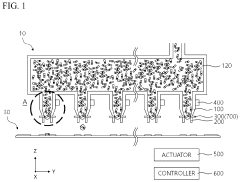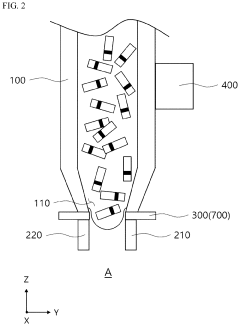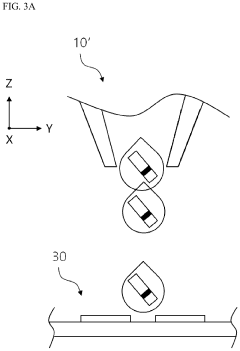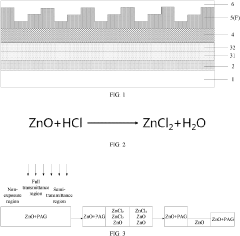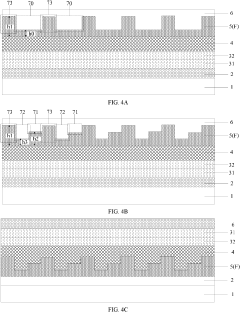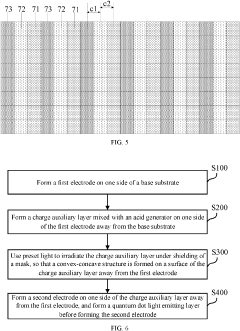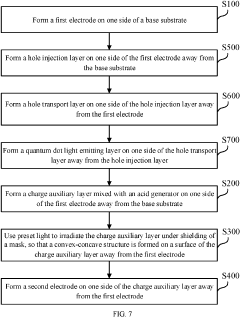How to Design Cost-Effective Displays with QNED Tech?
JUN 19, 20259 MIN READ
Generate Your Research Report Instantly with AI Agent
Patsnap Eureka helps you evaluate technical feasibility & market potential.
QNED Display Tech Evolution
The evolution of QNED (Quantum Nano-Emitting Diode) display technology represents a significant advancement in the field of display systems. This innovative technology combines the benefits of quantum dots and mini-LEDs to create a new class of displays that offer superior color performance, brightness, and energy efficiency.
QNED technology emerged as a response to the limitations of existing display technologies such as LCD and OLED. The development of QNED displays can be traced back to the early 2010s when researchers began exploring ways to enhance the color gamut and brightness of LED-backlit LCD screens. The breakthrough came with the integration of quantum dots into the LED structure, allowing for precise control over light emission at the nanoscale level.
The first major milestone in QNED evolution was the successful fabrication of blue quantum dot LEDs with high efficiency and stability. This achievement paved the way for the development of full-color QNED displays. Subsequent advancements focused on improving the manufacturing processes to reduce costs and increase production yields.
By the mid-2010s, researchers had made significant progress in optimizing the quantum dot materials and their integration with mini-LED backlight systems. This led to the creation of prototype QNED displays that demonstrated superior color accuracy, wider color gamut, and higher peak brightness compared to conventional LCD and OLED displays.
The late 2010s saw the refinement of QNED technology, with a focus on addressing challenges such as color stability, power consumption, and manufacturing scalability. Innovations in quantum dot synthesis and deposition techniques resulted in more uniform and efficient QNED panels. Additionally, advancements in mini-LED backlighting allowed for improved local dimming capabilities, enhancing contrast ratios and black levels.
In recent years, the evolution of QNED technology has accelerated, driven by increasing demand for high-performance displays in various applications, including televisions, monitors, and mobile devices. Manufacturers have invested heavily in research and development to overcome technical hurdles and bring QNED displays to market. This has led to the introduction of commercial QNED products, marking a significant milestone in the technology's evolution.
Looking ahead, the QNED display technology evolution is expected to continue, with a focus on further improving cost-effectiveness, energy efficiency, and overall performance. Researchers are exploring new quantum dot materials and manufacturing techniques to enhance color purity and reduce production costs. Additionally, efforts are underway to develop flexible and transparent QNED displays, opening up new possibilities for innovative product designs and applications.
QNED technology emerged as a response to the limitations of existing display technologies such as LCD and OLED. The development of QNED displays can be traced back to the early 2010s when researchers began exploring ways to enhance the color gamut and brightness of LED-backlit LCD screens. The breakthrough came with the integration of quantum dots into the LED structure, allowing for precise control over light emission at the nanoscale level.
The first major milestone in QNED evolution was the successful fabrication of blue quantum dot LEDs with high efficiency and stability. This achievement paved the way for the development of full-color QNED displays. Subsequent advancements focused on improving the manufacturing processes to reduce costs and increase production yields.
By the mid-2010s, researchers had made significant progress in optimizing the quantum dot materials and their integration with mini-LED backlight systems. This led to the creation of prototype QNED displays that demonstrated superior color accuracy, wider color gamut, and higher peak brightness compared to conventional LCD and OLED displays.
The late 2010s saw the refinement of QNED technology, with a focus on addressing challenges such as color stability, power consumption, and manufacturing scalability. Innovations in quantum dot synthesis and deposition techniques resulted in more uniform and efficient QNED panels. Additionally, advancements in mini-LED backlighting allowed for improved local dimming capabilities, enhancing contrast ratios and black levels.
In recent years, the evolution of QNED technology has accelerated, driven by increasing demand for high-performance displays in various applications, including televisions, monitors, and mobile devices. Manufacturers have invested heavily in research and development to overcome technical hurdles and bring QNED displays to market. This has led to the introduction of commercial QNED products, marking a significant milestone in the technology's evolution.
Looking ahead, the QNED display technology evolution is expected to continue, with a focus on further improving cost-effectiveness, energy efficiency, and overall performance. Researchers are exploring new quantum dot materials and manufacturing techniques to enhance color purity and reduce production costs. Additionally, efforts are underway to develop flexible and transparent QNED displays, opening up new possibilities for innovative product designs and applications.
Market Demand for QNED
The market demand for QNED (Quantum Nano-Emitting Diode) technology in displays is rapidly evolving, driven by the increasing consumer appetite for higher quality visual experiences and the need for more energy-efficient display solutions. QNED technology, which combines quantum dots with nano-LED backlighting, promises to deliver superior color accuracy, brightness, and contrast compared to traditional LCD and OLED displays.
In the consumer electronics sector, there is a growing demand for premium televisions and monitors that can offer HDR (High Dynamic Range) content with wider color gamuts and deeper blacks. QNED displays are well-positioned to meet these requirements, potentially capturing a significant portion of the high-end display market. Industry analysts project that the global premium TV market, where QNED is likely to compete, could reach substantial growth in the coming years.
The commercial display market also presents significant opportunities for QNED technology. Digital signage, control room displays, and large-format screens used in corporate and educational settings require high brightness, long lifespan, and energy efficiency – all attributes that QNED can potentially deliver. As businesses increasingly invest in advanced visual technologies for communication and data visualization, the demand for QNED displays in this sector is expected to rise.
In the mobile device market, while OLED currently dominates, there is potential for QNED to gain traction in tablets and laptops where larger screen sizes and higher brightness requirements align well with QNED's strengths. The automotive industry is another emerging market for QNED, as car manufacturers seek advanced display technologies for infotainment systems and digital dashboards that can perform well in high-ambient light conditions.
However, the market demand for QNED is not without challenges. The technology is still relatively new and faces competition from established display technologies like OLED and micro-LED. Cost-effectiveness will be a crucial factor in determining QNED's market penetration. As production scales up and manufacturing processes are optimized, the cost of QNED displays is expected to decrease, potentially making them more competitive in various market segments.
Environmental considerations are also shaping market demand. With increasing focus on sustainability, QNED's potential for improved energy efficiency compared to current technologies could be a significant driver of adoption, especially in regions with strict energy consumption regulations.
The success of QNED in meeting market demand will largely depend on its ability to deliver on its promised performance advantages while achieving cost parity with existing technologies. As research and development efforts continue to improve QNED technology, and as manufacturing capabilities expand, the market demand is expected to grow, potentially reshaping the display industry landscape in the coming years.
In the consumer electronics sector, there is a growing demand for premium televisions and monitors that can offer HDR (High Dynamic Range) content with wider color gamuts and deeper blacks. QNED displays are well-positioned to meet these requirements, potentially capturing a significant portion of the high-end display market. Industry analysts project that the global premium TV market, where QNED is likely to compete, could reach substantial growth in the coming years.
The commercial display market also presents significant opportunities for QNED technology. Digital signage, control room displays, and large-format screens used in corporate and educational settings require high brightness, long lifespan, and energy efficiency – all attributes that QNED can potentially deliver. As businesses increasingly invest in advanced visual technologies for communication and data visualization, the demand for QNED displays in this sector is expected to rise.
In the mobile device market, while OLED currently dominates, there is potential for QNED to gain traction in tablets and laptops where larger screen sizes and higher brightness requirements align well with QNED's strengths. The automotive industry is another emerging market for QNED, as car manufacturers seek advanced display technologies for infotainment systems and digital dashboards that can perform well in high-ambient light conditions.
However, the market demand for QNED is not without challenges. The technology is still relatively new and faces competition from established display technologies like OLED and micro-LED. Cost-effectiveness will be a crucial factor in determining QNED's market penetration. As production scales up and manufacturing processes are optimized, the cost of QNED displays is expected to decrease, potentially making them more competitive in various market segments.
Environmental considerations are also shaping market demand. With increasing focus on sustainability, QNED's potential for improved energy efficiency compared to current technologies could be a significant driver of adoption, especially in regions with strict energy consumption regulations.
The success of QNED in meeting market demand will largely depend on its ability to deliver on its promised performance advantages while achieving cost parity with existing technologies. As research and development efforts continue to improve QNED technology, and as manufacturing capabilities expand, the market demand is expected to grow, potentially reshaping the display industry landscape in the coming years.
QNED Tech Challenges
QNED (Quantum Nano Emitting Diode) technology faces several significant challenges in its journey towards becoming a cost-effective display solution. One of the primary hurdles is the complexity of the manufacturing process. The precise control required to create uniform quantum dot arrays on a large scale is technologically demanding and currently expensive. This complexity directly impacts production yields and overall costs.
Material costs pose another substantial challenge. The high-quality quantum dots and nanorod materials essential for QNED displays are currently expensive to produce in the quantities needed for mass production. The industry is actively seeking ways to reduce these material costs without compromising performance.
Stability and longevity of QNED displays present ongoing technical challenges. Quantum dots can be sensitive to environmental factors such as heat and moisture, potentially affecting the long-term reliability of displays. Developing robust encapsulation methods to protect the quantum dots while maintaining their optical properties is crucial for the technology's commercial viability.
Color accuracy and consistency across the display area remain areas of focus. Achieving uniform emission characteristics from all quantum dots in a large display is technically challenging. Variations in quantum dot size or composition can lead to color shifts, impacting overall display quality.
Power efficiency is another critical aspect that needs improvement. While QNED technology promises better energy efficiency than some existing display technologies, further optimization is required to make it truly competitive, especially for mobile and portable devices where battery life is paramount.
Integration with existing display manufacturing infrastructure presents both technical and economic challenges. Adapting current production lines or developing new ones specifically for QNED technology requires significant investment and technical expertise. This transition could be a barrier for some manufacturers looking to adopt the technology.
Scaling up production to meet potential market demand is a significant hurdle. The ability to produce QNED displays in large quantities while maintaining quality and cost-effectiveness is crucial for widespread adoption. This scaling challenge encompasses both technical and logistical aspects of manufacturing.
Lastly, the competitive landscape of display technologies poses a challenge for QNED. Established technologies like OLED and emerging ones like microLED are continually improving, setting high benchmarks for performance and cost. QNED must not only overcome its own technical hurdles but also demonstrate clear advantages over these competing technologies to gain market traction.
Material costs pose another substantial challenge. The high-quality quantum dots and nanorod materials essential for QNED displays are currently expensive to produce in the quantities needed for mass production. The industry is actively seeking ways to reduce these material costs without compromising performance.
Stability and longevity of QNED displays present ongoing technical challenges. Quantum dots can be sensitive to environmental factors such as heat and moisture, potentially affecting the long-term reliability of displays. Developing robust encapsulation methods to protect the quantum dots while maintaining their optical properties is crucial for the technology's commercial viability.
Color accuracy and consistency across the display area remain areas of focus. Achieving uniform emission characteristics from all quantum dots in a large display is technically challenging. Variations in quantum dot size or composition can lead to color shifts, impacting overall display quality.
Power efficiency is another critical aspect that needs improvement. While QNED technology promises better energy efficiency than some existing display technologies, further optimization is required to make it truly competitive, especially for mobile and portable devices where battery life is paramount.
Integration with existing display manufacturing infrastructure presents both technical and economic challenges. Adapting current production lines or developing new ones specifically for QNED technology requires significant investment and technical expertise. This transition could be a barrier for some manufacturers looking to adopt the technology.
Scaling up production to meet potential market demand is a significant hurdle. The ability to produce QNED displays in large quantities while maintaining quality and cost-effectiveness is crucial for widespread adoption. This scaling challenge encompasses both technical and logistical aspects of manufacturing.
Lastly, the competitive landscape of display technologies poses a challenge for QNED. Established technologies like OLED and emerging ones like microLED are continually improving, setting high benchmarks for performance and cost. QNED must not only overcome its own technical hurdles but also demonstrate clear advantages over these competing technologies to gain market traction.
Cost-Effective QNED Solutions
01 Manufacturing process optimization
QNED display cost-effectiveness can be improved through optimized manufacturing processes. This includes developing efficient methods for quantum dot synthesis, precise deposition techniques, and streamlined assembly procedures. Advanced fabrication technologies and automated production lines can reduce material waste and labor costs, contributing to overall cost reduction.- Manufacturing process optimization: QNED display cost-effectiveness can be improved through optimized manufacturing processes. This includes developing efficient methods for quantum dot synthesis, precise deposition techniques, and streamlined assembly procedures. Advanced fabrication technologies and automated production lines can reduce material waste and labor costs, contributing to overall cost reduction.
- Material selection and engineering: Careful selection and engineering of materials used in QNED displays can significantly impact cost-effectiveness. This involves researching and developing alternative, less expensive materials that maintain or improve performance. Nano-scale engineering of quantum dots and emitting layers can enhance efficiency, potentially reducing the amount of material required and lowering costs.
- Energy efficiency improvements: Enhancing the energy efficiency of QNED displays contributes to their cost-effectiveness over the product lifecycle. This includes optimizing quantum dot emission, improving light extraction techniques, and developing more efficient driving circuits. Higher energy efficiency can lead to reduced power consumption and extended device lifespan, offering long-term cost benefits.
- Scalability and mass production: Improving the scalability of QNED display production is crucial for cost-effectiveness. This involves developing manufacturing techniques that are suitable for large-scale production, standardizing processes, and optimizing supply chains. Economies of scale can significantly reduce per-unit costs as production volumes increase.
- Integration with existing display technologies: Cost-effectiveness of QNED displays can be enhanced by integrating them with existing display technologies and manufacturing infrastructures. This approach allows for leveraging established production facilities and processes, reducing the need for entirely new manufacturing setups. It also facilitates easier market adoption by building upon familiar technologies.
02 Material selection and engineering
Careful selection and engineering of materials used in QNED displays can significantly impact cost-effectiveness. This involves researching and developing alternative, less expensive materials that maintain or improve performance. Nano-scale engineering of quantum dots and emitting layers can enhance efficiency, potentially reducing the amount of material required and lowering costs.Expand Specific Solutions03 Energy efficiency improvements
Enhancing the energy efficiency of QNED displays contributes to their cost-effectiveness over time. This includes optimizing the quantum dot emission spectrum, improving light extraction techniques, and developing more efficient driving circuits. Higher energy efficiency can lead to reduced power consumption and extended device lifespan, offering long-term cost benefits.Expand Specific Solutions04 Scalability and mass production
Improving the scalability of QNED technology and establishing efficient mass production methods are crucial for cost-effectiveness. This involves developing large-area fabrication techniques, enhancing yield rates, and creating modular designs that facilitate easier manufacturing and assembly. Economies of scale can significantly reduce per-unit costs as production volumes increase.Expand Specific Solutions05 Integration with existing display technologies
Cost-effectiveness can be achieved by integrating QNED technology with existing display manufacturing infrastructure. This approach allows for the utilization of established production lines and processes, reducing the need for entirely new manufacturing setups. Hybrid designs that combine QNED elements with conventional display technologies can offer a balance between performance improvements and cost considerations.Expand Specific Solutions
QNED Industry Players
The QNED (Quantum Nano Emitting Diode) display technology market is in its early growth stage, with significant potential for expansion. The global market size for advanced display technologies is projected to reach billions of dollars in the coming years. QNED technology's maturity is advancing rapidly, with key players like BOE Technology Group, Samsung Display, and AUO Corp leading research and development efforts. These companies are investing heavily in QNED to achieve cost-effective production methods and improve display performance. Other notable contributors include TCL China Star Optoelectronics and Sharp Corp, who are also actively developing QNED solutions. As the technology matures, we can expect increased competition and innovation, driving down costs and improving accessibility for consumers.
BOE Technology Group Co., Ltd.
Technical Solution: BOE has developed a QNED (Quantum Nano Emitting Diode) display technology that combines quantum dot and mini-LED technologies. Their approach involves using a blue mini-LED backlight with red and green quantum dots to achieve high color gamut and contrast. BOE's QNED panels utilize advanced local dimming techniques to enhance contrast ratios and reduce power consumption. They have also implemented a unique quantum dot color conversion layer to improve color accuracy and efficiency.
Strengths: High color gamut, excellent contrast, and energy efficiency. Weaknesses: Potential for higher production costs and complexity in manufacturing process.
TCL China Star Optoelectronics Technology Co., Ltd.
Technical Solution: TCL CSOT has introduced their version of QNED technology, which they call H-QLED. This technology combines quantum dots with mini-LED backlighting to achieve superior color performance and contrast. Their approach focuses on optimizing the quantum dot layer to enhance color conversion efficiency and reduce light leakage. TCL CSOT has also developed a proprietary driving method to improve the overall display performance and reduce power consumption in their QNED panels.
Strengths: Excellent color reproduction and high contrast ratios. Weaknesses: Potential challenges in scaling up production and maintaining consistent quality across large panel sizes.
QNED Core Innovations
Inkjet head and method of ejecting ink using the same
PatentActiveUS11845276B2
Innovation
- An inkjet head with nozzles and pairs of electrodes that apply an electrode voltage to the light-emitting elements, including a first and second piezoelectric element, and a controller to independently control the electrode voltage, allowing for precise arrangement of light-emitting elements on a substrate with separate electrodes before and during the jetting process.
Display substrate, display device, and manufacturing method for display substrate
PatentPendingUS20230145503A1
Innovation
- A display substrate with a base substrate, a first electrode, a charge auxiliary layer featuring concave-convex structures and varying acid generator content, and a quantum dot light emitting layer, where the charge auxiliary layer is formed using a mask with different light transmittance regions to create periodic convex-concave structures that enhance light extraction by total reflection.
QNED Supply Chain Analysis
The QNED (Quantum Nano Emitting Diode) supply chain is a complex network of manufacturers, suppliers, and distributors working together to produce cost-effective displays using this innovative technology. At the core of the QNED supply chain are the manufacturers of quantum dots and nanorod LEDs, which form the basis of the QNED technology. These components are typically produced by specialized chemical companies with expertise in nanotechnology and materials science.
Key players in the QNED supply chain include major display manufacturers such as Samsung, LG, and TCL, who are investing heavily in QNED technology development. These companies work closely with quantum dot suppliers like Nanosys and Nanoco to secure a steady supply of high-quality materials. Additionally, LED manufacturers play a crucial role in providing the necessary blue LED backlights that excite the quantum dots.
The supply chain also encompasses producers of color conversion layers, which are essential for transforming the blue light into the desired red and green colors. These layers are often manufactured by companies specializing in optical films and coatings. Glass substrate suppliers, such as Corning and AGC, provide the foundation for QNED displays, while electronic component manufacturers contribute the necessary drivers and control circuits.
To ensure cost-effectiveness, the QNED supply chain relies on economies of scale and vertical integration. Large display manufacturers often invest in or acquire key suppliers to secure their supply and reduce costs. For instance, Samsung has invested in quantum dot producer Nanosys to guarantee a stable supply of materials for their QNED displays.
Logistics and transportation play a significant role in the QNED supply chain, as components and materials often need to be sourced from various global locations. Efficient inventory management and just-in-time delivery systems are crucial for minimizing costs and ensuring smooth production flows.
As QNED technology is still relatively new, the supply chain is evolving rapidly. Research institutions and startups are continually developing new materials and manufacturing processes, which may lead to disruptions and reconfigurations in the existing supply chain. This dynamic environment presents both challenges and opportunities for companies looking to establish themselves in the QNED market.
To further optimize costs, many companies in the QNED supply chain are investing in automation and advanced manufacturing techniques. These investments aim to increase production efficiency, reduce waste, and improve yield rates, all of which contribute to lowering the overall cost of QNED displays.
Key players in the QNED supply chain include major display manufacturers such as Samsung, LG, and TCL, who are investing heavily in QNED technology development. These companies work closely with quantum dot suppliers like Nanosys and Nanoco to secure a steady supply of high-quality materials. Additionally, LED manufacturers play a crucial role in providing the necessary blue LED backlights that excite the quantum dots.
The supply chain also encompasses producers of color conversion layers, which are essential for transforming the blue light into the desired red and green colors. These layers are often manufactured by companies specializing in optical films and coatings. Glass substrate suppliers, such as Corning and AGC, provide the foundation for QNED displays, while electronic component manufacturers contribute the necessary drivers and control circuits.
To ensure cost-effectiveness, the QNED supply chain relies on economies of scale and vertical integration. Large display manufacturers often invest in or acquire key suppliers to secure their supply and reduce costs. For instance, Samsung has invested in quantum dot producer Nanosys to guarantee a stable supply of materials for their QNED displays.
Logistics and transportation play a significant role in the QNED supply chain, as components and materials often need to be sourced from various global locations. Efficient inventory management and just-in-time delivery systems are crucial for minimizing costs and ensuring smooth production flows.
As QNED technology is still relatively new, the supply chain is evolving rapidly. Research institutions and startups are continually developing new materials and manufacturing processes, which may lead to disruptions and reconfigurations in the existing supply chain. This dynamic environment presents both challenges and opportunities for companies looking to establish themselves in the QNED market.
To further optimize costs, many companies in the QNED supply chain are investing in automation and advanced manufacturing techniques. These investments aim to increase production efficiency, reduce waste, and improve yield rates, all of which contribute to lowering the overall cost of QNED displays.
QNED Environmental Impact
The environmental impact of QNED (Quantum Nano Emitting Diode) technology is an important consideration in the development and adoption of cost-effective displays. QNED displays offer several potential environmental benefits compared to traditional display technologies, but also present some challenges that need to be addressed.
One of the primary environmental advantages of QNED technology is its potential for improved energy efficiency. QNED displays are expected to consume less power than conventional LCD and OLED displays, particularly in high-brightness applications. This reduced energy consumption can lead to lower carbon emissions and decreased strain on power grids, contributing to overall environmental sustainability.
The manufacturing process for QNED displays may also have a lower environmental footprint compared to some existing technologies. QNED production potentially requires fewer rare earth elements and toxic materials, which are often associated with negative environmental impacts in mining and disposal. This could result in reduced pollution and resource depletion throughout the product lifecycle.
Longevity is another factor that contributes to the environmental impact of display technologies. QNED displays are anticipated to have longer lifespans than OLED displays, which are prone to burn-in and degradation over time. Increased durability means fewer replacements and less electronic waste, aligning with circular economy principles and reducing the overall environmental burden of consumer electronics.
However, the environmental impact of QNED technology is not without challenges. The production of quantum dots, a key component in QNED displays, may involve the use of heavy metals or other potentially harmful materials. Proper handling, recycling, and disposal protocols must be established to mitigate any risks associated with these materials throughout the product lifecycle.
Additionally, the novelty of QNED technology means that large-scale recycling infrastructure for these displays does not yet exist. Developing efficient recycling processes and establishing a robust recycling ecosystem will be crucial to minimizing the end-of-life environmental impact of QNED displays.
As QNED technology advances, ongoing research and development efforts should focus on further improving energy efficiency, reducing the use of potentially harmful materials, and enhancing recyclability. Manufacturers should also consider implementing eco-design principles to ensure that QNED displays are easily disassembled and recycled at the end of their useful life.
In conclusion, while QNED technology shows promise for reducing the environmental impact of displays through improved energy efficiency and longevity, careful consideration must be given to material selection, manufacturing processes, and end-of-life management to fully realize its potential as an environmentally friendly display solution.
One of the primary environmental advantages of QNED technology is its potential for improved energy efficiency. QNED displays are expected to consume less power than conventional LCD and OLED displays, particularly in high-brightness applications. This reduced energy consumption can lead to lower carbon emissions and decreased strain on power grids, contributing to overall environmental sustainability.
The manufacturing process for QNED displays may also have a lower environmental footprint compared to some existing technologies. QNED production potentially requires fewer rare earth elements and toxic materials, which are often associated with negative environmental impacts in mining and disposal. This could result in reduced pollution and resource depletion throughout the product lifecycle.
Longevity is another factor that contributes to the environmental impact of display technologies. QNED displays are anticipated to have longer lifespans than OLED displays, which are prone to burn-in and degradation over time. Increased durability means fewer replacements and less electronic waste, aligning with circular economy principles and reducing the overall environmental burden of consumer electronics.
However, the environmental impact of QNED technology is not without challenges. The production of quantum dots, a key component in QNED displays, may involve the use of heavy metals or other potentially harmful materials. Proper handling, recycling, and disposal protocols must be established to mitigate any risks associated with these materials throughout the product lifecycle.
Additionally, the novelty of QNED technology means that large-scale recycling infrastructure for these displays does not yet exist. Developing efficient recycling processes and establishing a robust recycling ecosystem will be crucial to minimizing the end-of-life environmental impact of QNED displays.
As QNED technology advances, ongoing research and development efforts should focus on further improving energy efficiency, reducing the use of potentially harmful materials, and enhancing recyclability. Manufacturers should also consider implementing eco-design principles to ensure that QNED displays are easily disassembled and recycled at the end of their useful life.
In conclusion, while QNED technology shows promise for reducing the environmental impact of displays through improved energy efficiency and longevity, careful consideration must be given to material selection, manufacturing processes, and end-of-life management to fully realize its potential as an environmentally friendly display solution.
Unlock deeper insights with Patsnap Eureka Quick Research — get a full tech report to explore trends and direct your research. Try now!
Generate Your Research Report Instantly with AI Agent
Supercharge your innovation with Patsnap Eureka AI Agent Platform!
